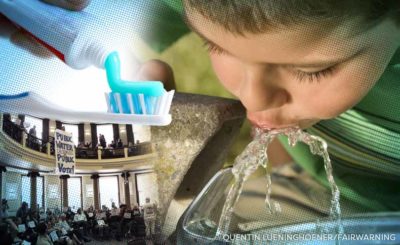Courtroom Battle Could Lead to Limits on Fluoridation of Drinking Water
A federal court trial underway in San Francisco could spell the beginning of the end of water fluoridation in America, potentially affecting drinking water for hundreds of millions of people across the U.S.
 Although fluoride can occur naturally in water, many water utilities add the chemical with the goal of improving dental health. But an alliance of groups led by Food & Water Watch, a government accountability nonprofit, have sued the Environmental Protection Agency to force it to limit or ban adding fluoride altogether. They contend that the chemical presents an “unreasonable risk’’ of causing neurological damage, especially to young children and babies in the womb.
Although fluoride can occur naturally in water, many water utilities add the chemical with the goal of improving dental health. But an alliance of groups led by Food & Water Watch, a government accountability nonprofit, have sued the Environmental Protection Agency to force it to limit or ban adding fluoride altogether. They contend that the chemical presents an “unreasonable risk’’ of causing neurological damage, especially to young children and babies in the womb.
In opening statements today, plaintiffs lawyer Michael Connett said it ”will be undisputed in this case that babies who are bottle-fed with fluoridated water receive the highest doses of fluoride of any age group.” At the time of “their greatest vulnerability, we are exposing infants, often from the poorest, most disadvantage communities, to a very high burden of fluoride,” Connett said.
But James Do, a Justice Department lawyer representing the EPA, said there are too many ”uncertainties and inconsistencies” in the evidence. “Let’s be one hundred percent clear here,” Do said. ”If EPA could conclude that there was an unreasonable risk from water fluoridation, EPA would regulate.”
As reported by FairWarning, water agencies first began adding fluoride in the 1940s, and today nearly 75 percent of Americans on public water systems are served fluoridated water. Fluoridation has been a lightning rod for crackpot conspiracy theories, including that it is part of a government plot to achieve mind control. Despite the outlandish nature of these fever dreams, fluoride is far from a benign chemical, health experts say.
As things stands, the Centers for Disease Control and Prevention (CDC) has set an advisory limit of 0.7 parts of fluoride per million parts of water as the optimum level to help prevent tooth decay while avoiding other problems associated with excessive fluoride exposure. These include dental fluorosis—which can lead to severe staining of the teeth, enamel erosion and pitting—and at much higher exposure levels skeletal fluorosis, a disease associated with joint pain, fractures and the bone disorder osteosclerosis.
But the EPA, which regulates drinking water quality, has not acted to limit the amount of fluoride that can be added. It requires that when fluoride concentrations exceed 2 parts per million parts that customers be alerted, and sets a maximum level of 4 ppm—an allowance for water systems with high levels of naturally occurring fluoride.
Want more stories like this? Sign up here to get news alerts.

Subscribe to receive occasional alerts in your inbox
According to the CDC, of approximately 275 million Americans on public water systems, more than 200 million are served water with fluoride added. An analysis by the Environmental Working Group, a research and advocacy organization, found that about 30 million people receive tap water with fluoride levels higher than the CDC recommendation.
Medical and dental authorities say that a small dose of the chemical is beneficial for dental health. The CDC claims that fluoridation reduces cavities by about 25% in children and adults. Still, a growing body of evidence suggests that Americans are routinely exposed to more fluoride than is good for them.
Experts point out that people already receive a daily dose of fluoride in toothpaste and mouthwash, and in many bottled drinks and processed foods. A key focus of the federal trial is a growing stack of scientific literature showing potential neurological harm from even low levels of fluoride.
In 2016, a 13-year study conducted in Mexico found that higher prenatal exposures to fluoride were associated with lower intelligence test scores for children later on. Between 2018 and 2019, several studies from Canada found similar effects, including that more fluoride in the urine of expectant mothers corresponded with an IQ loss in male children, and that youths from areas with fluoridated water had a higher prevalence of ADHD.
The EPA has asserted that there isn’t enough evidence showing neurological damage from low levels of fluoride, and that the benefits of fluoridation outweigh the risks.
Fluoride in the Water: Too Much of a Good Thing?
The case before U.S. District Judge Edward Chen began its slow road to trial in 2016, when the plaintiffs petitioned the EPA to begin the process of banning fluoridation. A court subsequently denied the EPA’s motion to dismiss the petition, setting the stage for the legal showdown. In the months leading up to the trial, judge Edward Chen made several rulings that carry the potential to shape its outcome, including one that bars the EPA from providing evidence of fluoride’s health benefits.
The case, being tried without a jury, was filed under the federal Toxic Substances Control Act, and this is the first time a citizen’s petition under that law has made it to the trial stage, Robert Sussman, a former EPA deputy administrator, told FairWarning. “This is very much a precedent setting case which is going down a road nobody’s traveled down before,” Sussman said.
If the plaintiffs are successful, the case won’t necessarily signal the end to water fluoridation, but could cause the EPA to limit how much fluoride can be added. Any new rules could take years to implement.
“This is a good public health exercise,” said Mike Keegan, regulatory analyst for the National Rural Water Association, which represents officials of small community water systems. “You want to make sure this is an asset you’re putting into the water supply.”
Did you like this story? Your support means a lot! Your tax-deductible donation in any amount will advance our mission of delivering strong watchdog reporting.
*** This article has been archived for your research. The original version from FairWarning can be found here ***


